I guess the right arm straightening is just getting from a higher plane (e.g. TSP) to the elbow plane, right?
If swinging on a higher plane, is there any other way of getting to the elbow plane other than this move?
I guess the right arm straightening is just getting from a higher plane (e.g. TSP) to the elbow plane, right?
If swinging on a higher plane, is there any other way of getting to the elbow plane other than this move?
Teddy - The uncoiling motion of the shoulder girdle also contributes to the lowering of the shaft plane.
Bom - either one can work, ie the right arm angle casting from the triceps will cause the wrist cock angle to open up from momentum/CF. and the wrists cock angle throw will cause momentum to leak into the right arm angle causing it to open. Most mid to high handicap golfers will either cast the right arm angle away and then a microsecond later, throw from the wrists or do both simultaneously.
Hit Impulse can be: wrist throwaway, right arm angle casting away, left upper arm pulling sideways or right upper arm pushing sideways (disconnection), right shoulder girdle firing independently OTT (no lower body shift/rotate and Core rotation preceding the shoulder girdle firing) or body lunging to the left. Yes - ball boundedness is the main cause. So is a strong belief in the items on my list as independent power sources, instead of a proper Pivot.
Mandrin,
I liked you comment, quoted below about the difficulty of avoiding muscular interference under pressure. It very sensible, interesting and excellently formulated.
You may remember that in my first post I said that complete “giving up” or “surrendering” to the natural laws of motion without any muscular interference requires inner security (which is associated with the ability to relax well). So I am aware of the objection you bring up. Swinging is especially likely to work well in people who are secure, which brings about the ability to keep calm in stressful situations like the Swedish pilots selected with the DMT test.
Your ability to play “10/10” when you are in that harmonious “flow” state, indicated to me that you have that potential. If a person has a certain level of subconscious trait anxiety (closely related to weak inner security) he would never be able to attain that 10/10 state because that brings about permanent disturbing tensions varying nature making it difficult to exactly reproduce a movement pattern.
However, I believe that most low handicappers and top golfers, like the majority of this forum participants, may have an enough high level of inner security to be able to make swinging work. If you are neurotically tension-ridden, It is extremely difficult to attain a very low handicap. Most successful pros have an evidently relaxed demeanor, (with a few exceptions - Nick Faldo and Bernard Langer comes to mind - with his putting freeze).
I think it is a matter of attitude. A famous Swedish sports psychologist, Kjell Enhager emphasized this. He is a former tour golfer recognized to be behind one of Sweden’s most successful results in the Olympic games. He is also renowned for rebuilding the career of Nick Faldo when he was about to drop out of the top 200 list in 1999. Enhager has been coaching several other top golfers, especially the Swedish US tour ladies. The key message of Enhager was to emphasize the importance of a positive attitude while performing. He emphasized focusing on a positive vision of the result of the swing rather than the swing itself. I am sure this is nothing new to you, but I think many don’t consider it seriously enough as it may seem too simple.
Also Moe Norman was very aware of this and emphasized therefore that you should let go of any inner performance pressure for best results. Here some quotes illustrating his attitude.
Actually the last quote indicates the state of “flow” that I mentioned in a former posting - being the uninvolved witness to the actions of the body.
I believe most of you could improve your level of “mental golf”. Enhager found that most good golfer could - with great results. I must agree that research indicates that it is easier for people with high inner security/low subconscious anxiety to “let go” of performance thinking. But I do believe that many of you are such people so it may be just a matter of changing mental habits and attitudes.
To reduce the risk of muscular interference, I suggest you consider Moe’s solution to use heavy clubs- with the same swing speed (if possible with the heavier club) you create more inertia and thereby the club will move more “like on a rail”.
In any case I am sure my point of simplifying the movements maximally would pay off to consider, because coordination is vulnerable to tensions and to microdamages. So why not, at least abandon the traditional two-plane setup and use Moes single axis with straight arms? It eliminates the complicated and vulnerable coordination act required to reach the impact point. A good video illustrating this is at http://moenormangolfacademy.org/free/singleplaneswing.aspx - do have a look it shows the difference very distinctly.
If you really want to hit why not adopt at least that part?
I’ve read Kjell Enhager’s book Quantum Golf a while back. I have to admit that I did play some really good golf after reading it. But getting in that state of mind for an entire round of golf is not easy, let alone doing it for 72 holes under tournament golf pressure cooker conditions.
Let me ask the good doctor, would you rather hit a soft five iron or a firm six iron into the last hole of a major championship?
I think Mac might have been under the influence of Joe Norwood at the time as this is precisely the movement from the top with the R arm/elbow that Norwood was preaching in the 80’s, although Mac’s route to the top and address angles were different than the Norwood system…so…it was almost a “hybrid” Norwood move. Sorry for using the term hybrid ![]() RR
RR
I know Mac used to talk to Norwood when he was learning the swing. Surely some influence there. I believe the grip may have come from Norwood, can’t quote me on that but I’ve heard it before.
How do you know that? Was it your feeling…or by experience… or someone told you
Moe had a straight arm at address…did he have a straight arm throughout his swing?.. No…so was he doing what people said he was doing. Did he actually tell the Natural Golf people what he was doing… The only similarity I ever saw from those Natural Golf people that stomped Moe and took his name away was the clubhead twist at the end of the follow thru. Watch the DVD or old commercial it’s pathetic. They stand there and swing and then point their arms out in front like Moe did and say they swung like him.
Anyhow that’s a rant to show that observation is all well and good…but it is really only an observation
[size=200]SIPTING?[/size]
This connects to my heretic suggestion in the last posting of combining Moe’s single plane swing with hitting. I am aware that this is a great departure from common hitting systems with arms close to the body.
As explained before, it is really difficult to be 100% consistent if the swing depends on active coordinated muscle action because it is so complex and therefore vulnerable to disturbances. Consequently, maximum possible simplification is likely to increase the possibilities of precisely consistent results. I believe it is this simplicity that is the key explanation of Moe’s consistency, and not some extraordinary talent.
I cannot imagine any simpler solution than that of Moe - to start with straight arms in such a way that when you return in the downswing you automatically hit the ball without complex coordinated position changes - with the body in very similar position as setup:
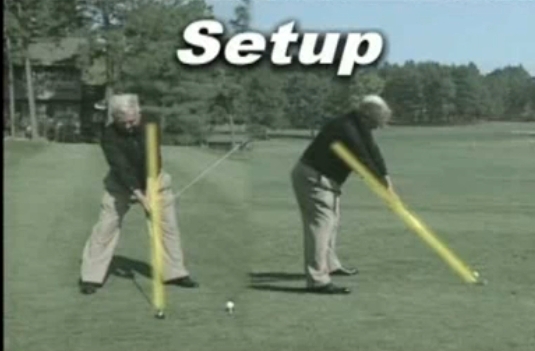
and impact:
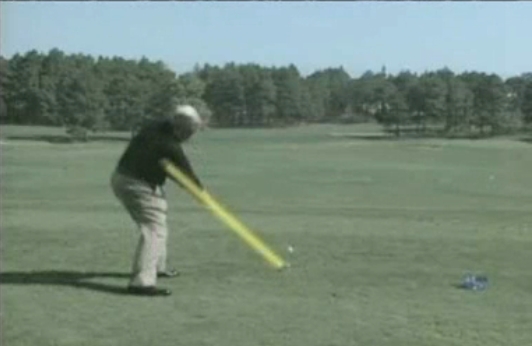
Compare this setup:
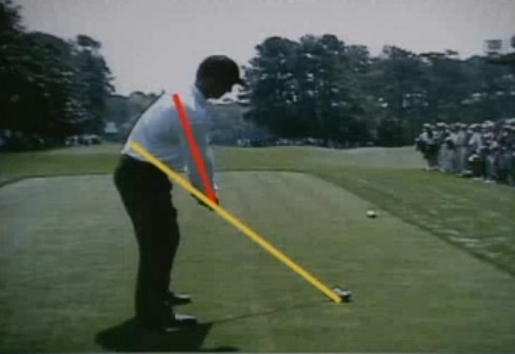
with the very much changed impact position that requires a complex act of coordination for hitting the ball because the centrifugal force has straightened the arms so you must move a bit away from the ball to hit it:
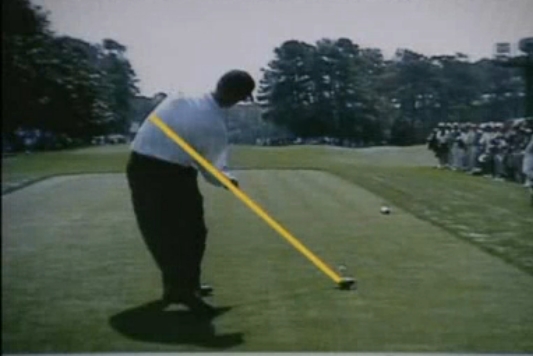
(Source of these images is the “single plane” video at Moe Norman Golf Academy http://moenormangolfacademy.org/free/singleplaneswing.aspx)
This twisting and bending is a complex and vulnerable coordination act that is much more difficult to reproduce exactly than the simple return of the club with straight arms to essentially the same body position as at the start of Moe’s single plane swing.
So why not eliminate this acrobatic coordination act and use the single plane even if you are hitting - “sipting” ![]() ?
?
TWO:
I envy your 20 “zone” rounds…I’ve had “2”. ![]()
Dr. Jaan:
In your first post I think, you mentioned returning to the game after a long layoff, or something like that. I’m curious how you found ABS. I know how I found it, and what I searched for and why…how did you find it?
From a rats perspective: it’s fine to know the practical and medical relevance of parasympathetic or sympathetic nervous systems, but it’s another thing to know the importance of listening to individuals with far more exposure to those processes in real-time situations. I just wish my own Dr. would listen to me more often ![]() RR
RR
…However, I believe that most low handicappers and top golfers, like the majority of this forum participants, may have an enough high level of inner security to be able to make swinging work. If you are neurotically tension-ridden…
Correct me if I’m wrong, but I think we all have been called insecure!?!
Hmmm…I’d say it’s more difficult to perform at a high level if you aren’t given a reliable method to perform the task at hand. Golf is an excellent example of this, I believe. Many very intelligent people and gifted athletes end up looking foolish. Insecurity or just plain conflicted with unrealiable thoughts trying to accomplish a task you are ill suited to perform in the first place?
I’m actually considering starting a similar forum to Lag’s, but with regard to Advanced Sexual Prowess (ASP). You see, I’m a sexual Tyrannosaurus and eventhough they are extinct…that works in my favor! Having tiny arms can make you pretty edgy too! (think about it) ![]()
Captain Chaos
…I understand Moe’s description that the swing gives a “feeling of freedom” - it is almost religious - you surrender to nature letting the natural laws do the job while you only provide a steady and easily reproducible platform for it (stance, fixed left leg, rotation only of the upper body etc). This is called “flow” in sports psychology …
Oh! You’re talking about The Force. That was discovered a long time ago in a galaxy far, far away. Your ability with The Force depends on your midi-chlorian count. Unfortunately, mine is somewhat low so I’m a hitter here at ABS. ![]()
Captain Chaos
I wondered where you’ve been Captain. ![]()
Oh yeah, Two: I meant to say your 12 “zone” rounds instead of 20. Maybe I should ask a good Dr. for ADD advice ![]() RR
RR
…It takes about 150 muscles to kiss. By that reckoning I’d be kissing my missus’ on the navel every few times I went for a peck on the cheek because it’s too hard to get it right…
Gusboh…you are in need of my new forum - Advanced Sexual Performance. Contact me if you want to improve your aim! ![]()
On a serious note, I couldn’t agree with you more. I did like the part about finding the very few Swedish Air Force pilots who did not exhibit any subconscious anxiety. I believe those people are called sociopaths and I’m not sure you want them piloting sophisticated war machines. That may just be me though.
Captain Chaos
BPGS1- thanks for the thoughts, man, interesting stuff. Would your thinking be to try to eliminate the hit impulse or to channel it and use it at the right time?
Twomasters- that was a great post back there, cool thoughts. You’re a patient man to say the least…
I think that’s a timely question Bom and one I have been thinking about, I look forward to BP’s answer.
My thoughts, it is a common trait for people to have nice practice swings then look like the octopus falling out of tree when a ball is placed down. Analyzing myself, I feel this fear of results makes my body goes into a ‘safety mode’, like a car does when having electronic ignition problems, a backup sport-coordination mode developed as a kid used to hit any type of ball with. It’s what the mind thinks is the best chance of securely hitting the ball.
Maybe the fight or flight response comes in to a smaller degree to the leader setting up for his approach on 18. Blood rushing to the arms and legs. I’ve definitely seen how my arms and legs instantly become overactive when a ball is placed down and my bloodless torso leading to poor pivot.
I don’t know if fear ever can be eliminated. We always hear ‘don’t worry about the results’, but if we, especially here, get heightened enjoyment out of a well struck ball, it is only to be expected that we fear a poor struck ball more as well. It is hard to just accept that you need lows to enjoy the highs and not care.
So assuming that will have this excess of blood sent to the limbs, it must somehow be channeled constructively. We know active arms are trouble, we know overly swaying legs are trouble. The isometric-style tensioning of keeping pressure in the arm pits and inside of legs are great blood-dissipators, and our hands, always our first weapon of choice in a fight, precise enough to still get the ball to the hole.
It would be a very interesting exercise to do an exhaustive analysis of golf instruction and just extract the essential ideas. I would not be surprised that it could be condensed to very little. One of those areas is the transition. There has to be a microsecond delay between going forward and down. But there are many ways of saying the same. Forever all is invented anew. Another interesting juicy area would be hitting versus swinging. Also what powers the swing.
Just a bit of some old stuff about swinging and hitting which came up almost randomly whilst looking for a specific article.:
Power Comes from the Legs, Right ? Wrong? GOLF Magazine Sept., 1977.
A panel discussion – participating… Gardner Dickinson, John Jacobs, Carol Mann, Harvey Pennick and Ernie Vossler .
Dickinson : ”I’ve used al the methods discussed so far, but I’d like to add a thought that’s been useful to my pupils. It concerns the first move down from the top of the swing. Rather than of thinking of moving the legs, which is what on hears so often, I prefer to have pupils feel as though they were pulling the hands down, leaving the chest facing to the right. This trick stops the club from going on a outside-to-in track and also prevents them from using their shoulders to soon.”
John Jacobs : “On that point I would like to quote from a book Harry Vardon wrote about 1950. He said that from the top of the back swing, you wanted to get the hands down about hip high before anything else moves. He got a big shock at the end of his career when high speed photographs proved that wasn’t what actually happened. But that’s what he felt happened . And that what is important in learning the swing … feel. “
Are You A Swinger or a Hitter?, Dick Farley and Rick McCord, Golf Magazine, Yearbook1984
(Comparative analysis of Nicklaus and Palmer)
Swinger’s Downswing - “ For the swinger, the hips start the downswing, sliding to the left. The lower body motion pulls both arms and club down and brings the right elbow in close to your side. As soon you feel the pull of the clubhead, allow centrifugal force to complete the swing.“
Hitter’s downswing - 'For the hitter, the key word coming down is ”drive” – drive the right arm right through the ball. The straightening of the right arm does all the work, supplying power, uncocking the wrists and squaring the clubface to the ball. You must of course coordinate the right arm action with the shifting of weight to the left side. In contrast to a swinger, you are very much in control of the club; that control being the essence of the hitting action. You apply the clubface to the ball. An important point is to keep the right wrist bent back as the right arm straightens. If you allow the right wrist to straighten, or throw, you’ll hit too early.“
’ Right On! - For consistent accuracy learn to drive your whole right side’, Golf Magazine, November 1986.
I like this interesting article by Johnny Miller.

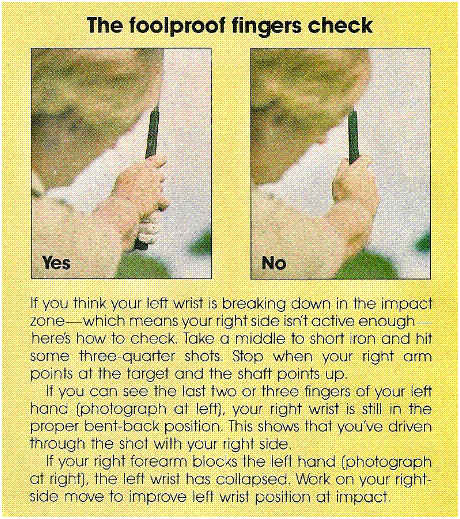
[i]“Most golfers instinctively release the right hand and arm as their main source of power. Although you can hit excellent shots this way, to be consistent you need perfect timing, something most golfers don’t have. You breed consistency by keeping the left wrist leading the clubhead through impact zone, which keeps the clubhead moving along the target line longer. To accomplish this the right wrist must be kept from bending forward into a fully released or extended position; it should retain a slight angle at impact, or as I like to say, some “wrinkles” at the back. How do you prevent your right hand from overpowering the left ? By driving the entire right side- from the right foot up through your rib cage – strongly and fluidly through the impact zone.”
“The correct right-side action then, is the opposite what golfers believe. They think that the left wrist breaks down if you use too much right side. But if you drive the right leg, hip and side toward the target through impact, the right hand stays cocked and doesn’t over power the left. Conversely, if the right side does nothing during impact, the right forearm and hand will take over. [/i]
This is not unlike Mark Evershed. Very strong on keeping the trail wrist bent throughout. Other interesting points of Evershed are vertical drop, constantly correct clubface plane and swinging left past impact. Probably not that far from lag’s concepts, expressed differently.
Johnny Miller’s comments make sense to me. It says that if you move the whole right quickly enough it prevents the instinctive release action of elbow and wrist. A similar idea expressed rather differently by Nick Price in his book, ‘The Swing’.
“Here is a superb feeling to strive for as you are pouring the power on through the ball. While your left side is opening up and clearing as you come into impact, feel that you hit the ball as hard as you can with your right arm and shoulders, and that you are now covering the ball with your right shoulder and are chasing the ball down the target line with it. This is an exciting sensation that I am always striving for and that I hope I can create to the end of my golfing days. And I wish the same for you.”
Indeed, if the right shoulder move quickly into the shot, it prevents premature and instinctive use of right elbow extension and right wrist release. In a sense it is similar to pushing a heavy shopping cart down a slope. If you keep running faster and faster there is no instinctive reaction to straighten the arms to increase speed. However as soon as one runs out of steam, likely very soon, ![]() , the arms immediately want to straighten to give that last little push.
, the arms immediately want to straighten to give that last little push.
At the end of this long rant I like to suggest a distinguishing element between swinging and hitting. Swinging involves mainly acceleration during the first halve of the down swing and a letting go, free wheeling through impact. Hitting is usually a shortish but constant vigorous action culminating at, through and past impact. Hence two quite distinct acceleration patterns. What intrigues me a bit is is that Lag sees, if I remember correctly, Moe Norman as a perfect swinger. Yet a swinger normally has an ample and fluid swing action. Moe has a rather short stubby looking swing action.
Thanks for the wonderful post Mandrin,
I know that took you a lot of time to put the together, and it’s posts like that the really make this such a wonderful site.
I would echo your thoughts on hitting and swinging, and as much as I would like to view Moe as a hitter, his hands release so fast into a full roll post impact, that the only way he can really do that is to have dead passive hands.
A hitter’s firm tense hands tearing through impact work more as motors, not fast flailing hinges as Moe puts to use. Moe swinging on a shoulder based swing plane is consistent with the objectives of swinging protocol, with the the end result being a fully extended left arm and clubshaft.
The thing that I see working so well with Moe is a constant and powerful pivot pull all the way to finish… and that pull is very much alive feeling in the left shoulder socket.
I agree with Bio that the pivots of hitters or swingers need not be substantially different… but the path of the hands and the protocols for managing wrist cock however would be very different… with very polarized intentions.
I must admit, after I filmed Moe in the late 80’s with my own 10K shutter speed camera… I was pretty shocked when I looked at the footage that night in my hotel room in Ponoka. Moe would always talk about hitting the ball with his chest and legs, with passive hands, so that did confirm what I saw… but his talk about not ever rolling the clubface over post impact was not reality… even if he was feeling this… there are many that do that move much better than Moe… and probably no one better than Jim Furyk.
The Hit Impulse is NOT solely the early release of the wrist cock angles as I said in my earlier post. It has other aspects, ie upper arm “sideways” swinging disconnection, which should never ever occur from independent muscle power and only then well after impact due to momentum, and the body lunge which should never ever occur. It is also how and in what direction the wrist cock angle and right arm angle release. Average golfers - once they have learned to delay the early release impulse - will still release the wrist cock angles and right arm angle in the wrong direction, ie the forward or toward the ball and target direction, or Northwest to use my earlier analogy. This creates instant flipping and loss of flat left wrist during or before impact.
I am fine with a hit with either the right arm angle or wrists or both as long as it is done in the correct down and out - and not forward - dimension. And starting no earlier than P3. IF the student can really do those two things. Most cannot in my experience. In truth, there is a little bit of forward dimension to it due to the right spine tilt and optionally arm rotation clockwise during Transition, but I don’t ever want my students to think about it that way and they already conceive it to be 100% sideways in the forward dimension.
At Balance Point, we are really big on controlling Low Point and angle of Attack, and we know that early release and wrong direction of release of wrist cock angle is so very common a Fatal Flaw. Why encourage it? This is one of the top reasons why average golfers come up out of their spine angle and hit thin and topped shots. They are coming up to create space required by the five inch longer clubhshaft that is a result of the early release. The steeper angle of attack which is the effect of the early release will cause them to hit the ground hard about a foot behind the ball - unless they stand up!
Lag,
I do indeed very much appreciate your comments. Since both you and others just recently made some sweet remarks I feel also inspired and justified to do the same. ![]()
I have been around golf forums for quite a while but I have never seen a group of people discussing golf being so articulated and connoisseur as on this golf forum. ![]()
![]()
![]()
Your forum is also light-years ahead when compared to various other golf forums, such as iseekgolf and LBG, which make one despair about the future of human mankind. ![]()
Your remarks made me remember discussing indeed this remarkable fast closing of his club face beyond impact on Moe Norman’s inspired Single-Axis Golf Forum, already many moons ago.
The Hit Impulse is NOT solely the early release of the wrist cock angles as I said in my earlier post. It has other aspects, ie upper arm “sideways” swinging disconnection, which should never ever occur from independent muscle power and only then well after impact due to momentum, and the body lunge which should never ever occur. It is also how and in what direction the wrist cock angle and right arm angle release. Average golfers - once they have learned to delay the early release impulse - will still release the wrist cock angles and right arm angle in the wrong direction, ie the forward or toward the ball and target direction, or Northwest to use my earlier analogy. This creates instant flipping and loss of flat left wrist during or before impact.
I am fine with a hit with either the right arm angle or wrists or both as long as it is done in the correct down and out - and not forward - dimension. And starting no earlier than P3. IF the student can really do those two things. Most cannot in my experience. In truth, there is a little bit of forward dimension to it due to the right spine tilt and optionally arm rotation clockwise during Transition, but I don’t ever want my students to think about it that way and they already conceive it to be 100% sideways in the forward dimension.
At Balance Point, we are really big on controlling Low Point and angle of Attack, and we know that early release and wrong direction of release of wrist cock angle is so very common a Fatal Flaw. Why encourage it? This is one of the top reasons why average golfers come up out of their spine angle and hit thin and topped shots. They are coming up to create space required by the five inch longer clubhshaft that is a result of the early release. The steeper angle of attack which is the effect of the early release will cause them to hit the ground hard about a foot behind the ball - unless they stand up!
BPGS1,
Let me try to condense in nutshell what you are saying.
Connection during down swing should be maintained.
East, or going away initially from the target, is very important, but mostly forgotten.
East going till P3 and only than still not including west but rather north east.
Result of foregoing - correct low point, angle of attack and clean crisp impact.